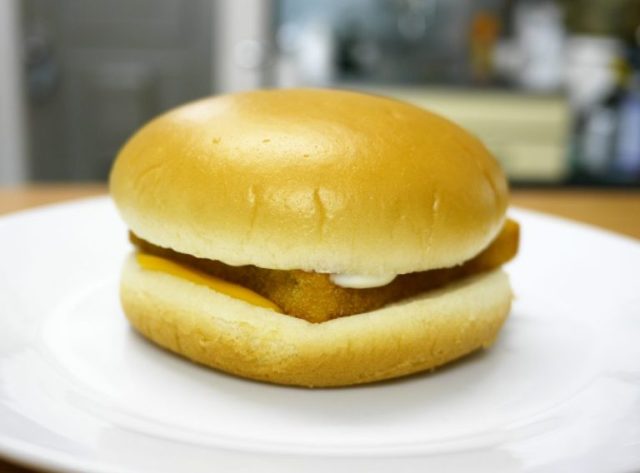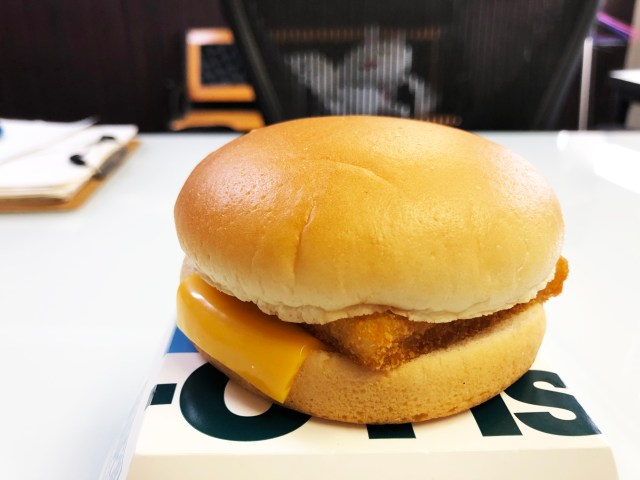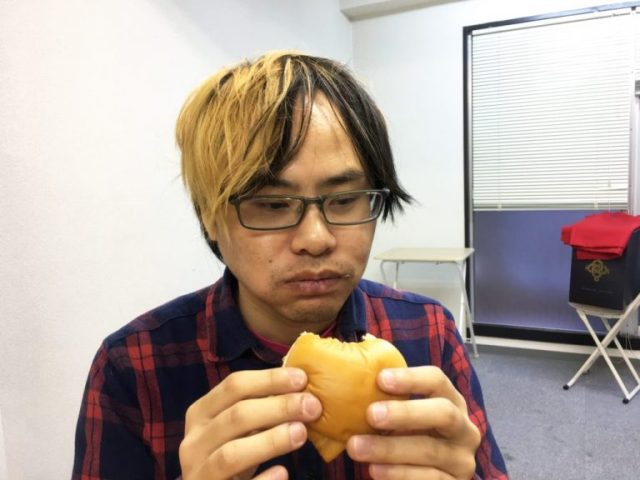
We have the technology. We can make it better, crispier, fresher.
Since 1971, the Filet-O-Fish has graced the menu of Japanese McDonald’s. Here these simple fish burgers never demanded attention like the ostentatious Big Macs or Quarter Pounders (now extinct in Japan), but stood strong in the background, always confident in its own deliciousness.
This modesty and quiet strength has made it especially popular in Japan where you can even find it on the breakfast menu.
▼ Just look at how much our own Seiji Nakazawa loves them
The last big change for the Filet-O-Fish occurred in 1994 when the fish meat changed from Pacific cod to Alaskan pollock, and since then, the simple recipe of a breaded fillet of fish, slice of cheese, and tartar sauce on a bun remained untouched.
The old rule, “if it ain’t broke, don’t fix it,” certainly applies, but a lot can happen in 25 years, so sure enough, a way to make the Filet-O-Fish even better has come along.
As the video outlines, the improvement comes by changing the way the fillets are produced. You might be surprised to learn that fish aren’t naturally square-shaped and need to undergo a process of skinning, deboning, and molding into a “fish block” first.
Up until now, this process had been entirely done in Thailand, which meant the Alaskan cod would have to be caught in the Bearing Sea and frozen. Then, it would be shipped to Thailand, thawed, processed, frozen again, and shipped to Japan.
But now the Japanese-owned Thai-based processing company Delmar has set up shop in Alaska, so the fish can be made into fish blocks on-site. From there it is still getting shipped to Thailand to be squared and breaded but doesn’t need to be thawed, resulting in a fresher fish meat that has only been frozen once instead of twice.
▼ I’m not sure how I feel that fish blocks do more traveling than I do.
It’s a revolution in the Filet-O-Fish industry, but netizens were largely unimpressed and suspicious.
“I think it’s gotten smaller recently.”
“They should put more mayo in the tartar sauce. It’s too tart.”
“Personally, I would like it if they put a full slice of cheese on it like in the old days.”
“Everyone I know hates the Filet-O-Fish, but I like it.”
“Mos Burger has a better fish sandwich.”
“I heard it was all just earthworms anyway.”
“Whenever I hear a product is getting ‘improved’ I expected it to become smaller and more expensive.”
The new Filet-O-Fishes will be sold at the same price of 340 yen (US$3.12) and have already hit most stores. All locations in Japan will have made the conversion by the end of October, so thanks to our vast archive of McDonald’s chronicling we now can see if it has really changed sizes at all.
▼ Classical Filet-O-Fish (circa 2017)
▼ Modern Filet-O-Fish (late 2019)
So, it would appear that while people’s tolerance of the term “weak sauce” has shrunk considerably since 2017, the Japanese Filet-O-Fish has not.
Still, given the fact that they are now frozen only once instead of twice, the argument over whether the Filet-O-Fish has become “much better” or simply “less crappy” really boils down to whether you’re a glass half-full or half-empty type, as well as personal preference.
▼ Isn’t that right, Seij…KEEP EATING!!!
But for fans of the Filet-O-Fish, this is good reason to rejoice. The battle for a full slice of cheese, however, will have to wait for another day…
Source: McDonald’s Japan, With News, My Game News Flash
Photos ©SoraNews24
● Want to hear about SoraNews24’s latest articles as soon as they’re published? Follow us on Facebook and Twitter!






 McDonald’s Japan’s first-ever rice fish burger is here, but was it worth the wait?【Taste test】
McDonald’s Japan’s first-ever rice fish burger is here, but was it worth the wait?【Taste test】 Why does McDonald’s Japan sell more Filet-O-Fish when it rains?
Why does McDonald’s Japan sell more Filet-O-Fish when it rains? McDonald’s Japan to introduce a super cheap Value Lunch menu
McDonald’s Japan to introduce a super cheap Value Lunch menu Are the new shrimp nuggets from McDonald’s Japan better than chicken McNuggets?
Are the new shrimp nuggets from McDonald’s Japan better than chicken McNuggets? Japan continues to shun processed fish sticks, opts for minimally processed fish cubes instead
Japan continues to shun processed fish sticks, opts for minimally processed fish cubes instead McDonald’s new Happy Meals offer up cute and practical Sanrio lifestyle goods
McDonald’s new Happy Meals offer up cute and practical Sanrio lifestyle goods All-you-can-drink Starbucks and amazing views part of Tokyo’s new 170 meter-high sky lounge
All-you-can-drink Starbucks and amazing views part of Tokyo’s new 170 meter-high sky lounge McDonald’s Japan releases a pancake pie for new retro kissaten coffeeshop series
McDonald’s Japan releases a pancake pie for new retro kissaten coffeeshop series Studio Ghibli glasses cases let anime characters keep an eye on your spectacles
Studio Ghibli glasses cases let anime characters keep an eye on your spectacles Kyoto’s 100 Demons yokai monster parade returns!
Kyoto’s 100 Demons yokai monster parade returns! The oldest tunnel in Japan is believed to be haunted, and strange things happen when we go there
The oldest tunnel in Japan is believed to be haunted, and strange things happen when we go there More foreign tourists than ever before in history visited Japan last month
More foreign tourists than ever before in history visited Japan last month Mister Donut ready to make hojicha dreams come true in latest collab with Kyoto tea merchant
Mister Donut ready to make hojicha dreams come true in latest collab with Kyoto tea merchant Super Nintendo World expansion gets delayed for several months at Universal Studios Japan
Super Nintendo World expansion gets delayed for several months at Universal Studios Japan Hamster abandoned at Tokyo ramen restaurant gets new home
Hamster abandoned at Tokyo ramen restaurant gets new home Disney princesses get official manga makeovers for Manga Princess Cafe opening in Tokyo
Disney princesses get official manga makeovers for Manga Princess Cafe opening in Tokyo Starbucks reopens at Shibuya Scramble Crossing with new look and design concept
Starbucks reopens at Shibuya Scramble Crossing with new look and design concept Beautiful new Final Fantasy T-shirt collection on the way from Uniqlo【Photos】
Beautiful new Final Fantasy T-shirt collection on the way from Uniqlo【Photos】 Is the new Shinkansen Train Desk ticket worth it?
Is the new Shinkansen Train Desk ticket worth it? Foreign English teachers in Japan pick their favorite Japanese-language phrases【Survey】
Foreign English teachers in Japan pick their favorite Japanese-language phrases【Survey】 Japanese convenience store packs a whole bento into an onigiri rice ball
Japanese convenience store packs a whole bento into an onigiri rice ball We try out “Chan Ramen”, an underground type of ramen popular in the ramen community
We try out “Chan Ramen”, an underground type of ramen popular in the ramen community Studio Ghibli releases Kiki’s Delivery Service chocolate cake pouches in Japan
Studio Ghibli releases Kiki’s Delivery Service chocolate cake pouches in Japan Japan’s bone-breaking and record-breaking roller coaster is permanently shutting down
Japan’s bone-breaking and record-breaking roller coaster is permanently shutting down New definition of “Japanese whiskey” goes into effect to prevent fakes from fooling overseas buyers
New definition of “Japanese whiskey” goes into effect to prevent fakes from fooling overseas buyers Our Japanese reporter visits Costco in the U.S., finds super American and very Japanese things
Our Japanese reporter visits Costco in the U.S., finds super American and very Japanese things Studio Ghibli unveils Mother’s Day gift set that captures the love in My Neighbour Totoro
Studio Ghibli unveils Mother’s Day gift set that captures the love in My Neighbour Totoro Foreign passenger shoves conductor on one of the last full runs for Japan’s Thunderbird train
Foreign passenger shoves conductor on one of the last full runs for Japan’s Thunderbird train Domino’s Japan now sells…pizza ears?
Domino’s Japan now sells…pizza ears? New Japanese KitKat flavour stars Sanrio characters, including Hello Kitty
New Japanese KitKat flavour stars Sanrio characters, including Hello Kitty Kyoto creates new for-tourist buses to address overtourism with higher prices, faster rides
Kyoto creates new for-tourist buses to address overtourism with higher prices, faster rides Sales of Japan’s most convenient train ticket/shopping payment cards suspended indefinitely
Sales of Japan’s most convenient train ticket/shopping payment cards suspended indefinitely Sold-out Studio Ghibli desktop humidifiers are back so Totoro can help you through the dry season
Sold-out Studio Ghibli desktop humidifiers are back so Totoro can help you through the dry season Japanese government to make first change to romanization spelling rules since the 1950s
Japanese government to make first change to romanization spelling rules since the 1950s Ghibli founders Toshio Suzuki and Hayao Miyazaki contribute to Japanese whisky Totoro label design
Ghibli founders Toshio Suzuki and Hayao Miyazaki contribute to Japanese whisky Totoro label design Doraemon found buried at sea as scene from 1993 anime becomes real life【Photos】
Doraemon found buried at sea as scene from 1993 anime becomes real life【Photos】 Tokyo’s most famous Starbucks is closed
Tokyo’s most famous Starbucks is closed One Piece characters’ nationalities revealed, but fans have mixed opinions
One Piece characters’ nationalities revealed, but fans have mixed opinions We asked a Uniqlo employee what four things we should buy and their suggestions didn’t disappoint
We asked a Uniqlo employee what four things we should buy and their suggestions didn’t disappoint Princesses, fruits, and blacksmiths: Study reveals the 30 most unusual family names in Japan
Princesses, fruits, and blacksmiths: Study reveals the 30 most unusual family names in Japan Sushi vinegar for your McDonald’s hamburger? We create the Japan dip sandwich【Taste test】
Sushi vinegar for your McDonald’s hamburger? We create the Japan dip sandwich【Taste test】 McDonald’s new toppings yield a cheap surprise: Hidden Chicken Crisp for 140 yen!
McDonald’s new toppings yield a cheap surprise: Hidden Chicken Crisp for 140 yen! McDonald’s Japan goes beyond chicken by adding shrimp nuggets to menu
McDonald’s Japan goes beyond chicken by adding shrimp nuggets to menu How to choose a great block of sashimi-grade tuna – 66-year maguro master shares his protips
How to choose a great block of sashimi-grade tuna – 66-year maguro master shares his protips McDonald’s Japan brings out a new chicken burger with rice buns
McDonald’s Japan brings out a new chicken burger with rice buns We have Norway to thank for salmon sushi and they’re planning even more for Good Meat Day
We have Norway to thank for salmon sushi and they’re planning even more for Good Meat Day McDonald’s Japan adds first-ever shrimp rice burger to menu in gohan sandwich expansion
McDonald’s Japan adds first-ever shrimp rice burger to menu in gohan sandwich expansion Wendy’s releases…American moon-viewing burgers in Japan?
Wendy’s releases…American moon-viewing burgers in Japan? The weird thing about Domino’s Japan’s Fish and Chips Pizza isn’t the fish or chips【Taste test】
The weird thing about Domino’s Japan’s Fish and Chips Pizza isn’t the fish or chips【Taste test】 7-Eleven Japan’s “Paper Tiger” sandwich sparks online controversy over deceptive packaging
7-Eleven Japan’s “Paper Tiger” sandwich sparks online controversy over deceptive packaging Startling video from Japan shows beheaded fish’s body is not ready to rest in peace yet【Video】
Startling video from Japan shows beheaded fish’s body is not ready to rest in peace yet【Video】 McDonald’s Japan celebrates Halloween by joining the dark burger revolution
McDonald’s Japan celebrates Halloween by joining the dark burger revolution Japanese ad’s swimming salmon cutlets confuse, educate children about dinner comes from【Video】
Japanese ad’s swimming salmon cutlets confuse, educate children about dinner comes from【Video】 Burger King’s new all-cheese The Real Cheese Burger looks crazy, sort of makes linguistic sense
Burger King’s new all-cheese The Real Cheese Burger looks crazy, sort of makes linguistic sense Michelin-approved Japanese chef teaches us two gourmet-standard dishes using ice cream and toast
Michelin-approved Japanese chef teaches us two gourmet-standard dishes using ice cream and toast
Leave a Reply